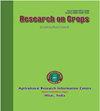泰米尔纳德邦 Periyar Vaigai 指挥区直播稻(Oryza sativa L. )的种植方法和种子包衣技术对其产量的影响
Q3 Agricultural and Biological Sciences
引用次数: 0
摘要
水稻是世界各地指挥区广泛种植的重要主食作物。在指挥区,由于水源区降雨量不足,水的释放量也不尽相同。为了应对这种情况,可以选择直接播种(DS)方法;但是,为了提高水稻种植的收益率,需要明确改进每滴种子过多、种子散落以及疏苗、间隙填充和杂草生长过多等间作操作等缺陷。因此,2022-24 年期间在马杜赖农业学院和研究所的中央农场进行了一项研究试验,以开发一种合适的直播方法。本次调查采用分小区设计,包括四个主小区处理和四个子小区处理,重复三次。主小区处理包括不同的播种方法(S),子小区处理包括不同的种子包衣技术(P)。实验结果表明,纸卷播种和 DS + 种子包衣 @ 2% KNO3 fb 芽孢杆菌和氮气鞘霉菌(PR + P-KN)组合在谷物产量(6150 千克/公顷)和秸秆产量(7824 千克/公顷)方面表现较好。在 B:C 比率方面,OS-GP + P-KN 较高,为 2.64,PR + P-KN 紧随其后,为 2.61。水稻滚筒播种机圆槽和干播(RS + DS)组合的效果最小。对不同地区的直播和种子包衣技术进行研究至关重要,尤其是在水排放仍然不可预测的管制地区。本文章由计算机程序翻译,如有差异,请以英文原文为准。
Influence of establishment methods and seed coating techniques on the performance of direct seeded rice (Oryza sativa L.) under Periyar Vaigai command area of Tamil Nadu
Rice is a crucial staple crop cultivated extensively in command areas worldwide. In the command areas, the release of water varies due to the inadequate amount of rainfall in the source area and its proper supply. To combat such situations, direct seeding (DS) methods can be opted for; however, lacunae like excess seeds per drop, scattering of seeds, and intercultural operations like thinning, gap filling, and excess weed growth need a clear refinement to enhance the profitability of rice cultivation. Therefore, a research trial was conducted during 2022-24 at Central Farm, Agricultural College and Research Institute, Madurai, to evolve a suitable direct seeding method. The present investigation was laid out under a split-plot design comprising four main plot treatments and four subplot treatments replicated thrice. The main plot treatments comprised different seeding methods (S) and the subplot treatments comprised different seed coating techniques (P). Based on the experimental results, paper roll seeding and DS + Seed coating @ 2% KNO3 fb Bacillus sp. and Azospirillum (PR + P-KN) combination performed better on establishment with grain (6150 kg/ha) and straw yield (7824 kg/ha) respectively. Regarding the B:C ratio, OS-GP + P-KN resulted in higher with 2.64, closely followed by PR + P-KN with 2.61. The least effect was recorded in the combination of round slots in rice drum seeder and dry seeding (RS + DS). Investigating different techniques of direct seeding and seed coating is essential across various regions, particularly in regulated areas where water discharge remains unpredictable.
求助全文
通过发布文献求助,成功后即可免费获取论文全文。
去求助
来源期刊

Research on Crops
Agricultural and Biological Sciences-Soil Science
CiteScore
1.50
自引率
0.00%
发文量
93
审稿时长
1 months
期刊介绍:
The Research on Crops is a peer-reviewed journal publishing original research papers, review articles and short communications in English on all basic and applied aspects of crop sciences, agricultural water management, agro-climatology, agroforestry, agronomy, crop production, crop protection, cropping systems, food science & technology, genetics & plant breeding, horticulture, plant & soil science, plant biotechnology, plant nutrition, post-harvest management of crops, seed science, soil management & tillage, vegetables, weed science, agricultural engineering, agri-business, agricultural economics and extension, etc. The aim of the journal is to provide a forum for the scientific community to publish their latest research findings.
The manuscripts submitted for publication should not contain data older than 4 years on the date of submission.
The articles submitted for publication in this journal should not be submitted elsewhere simultaneously for publication in another journal. These should not carry any copyright material without prior permission of copyright holder.
The articles should present a complete picture of the investigation made and should not be split into parts.
There is no prescribed limit regarding the number of pages in case of full-length articles. However, the authors are advised to keep the length of their articles from 4 to 10 full printed pages of the journal.
The articles should be divided into the sub-sections: ABSTRACT, INTRODUCTION, MATERIALS AND METHODS, RESULTS AND DISCUSSION, CONCLUSIONS, and REFERENCES. Tables and figures should be appended separately at the end.
 求助内容:
求助内容: 应助结果提醒方式:
应助结果提醒方式:


